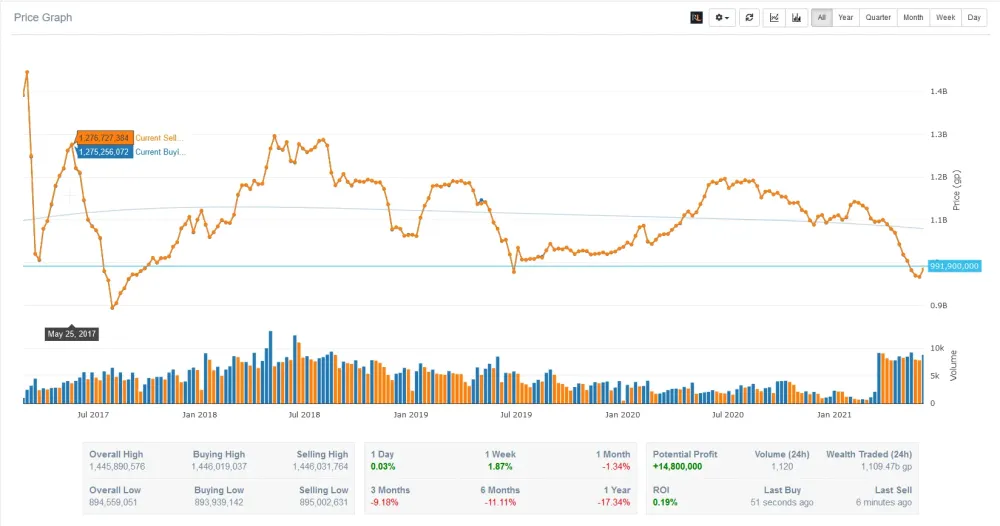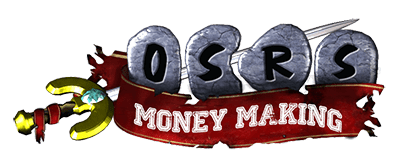Your cart is empty
Understanding OSRS GE Price History: A Comprehensive Guide

The Old School RuneScape (OSRS) Grand Exchange (GE) is a central marketplace where players buy and sell items using in-game currency. Understanding the dynamics of the GE is crucial for players looking to maximize their profits and effectively manage their in-game economy. This guide will delve into the GE price history, providing insights into how prices fluctuate over time and how players can utilize this information to make informed trading decisions.
GE Price History refers to the historical data that tracks the prices of items traded within the Grand Exchange over varying time frames. This data is essential for players who want to understand market trends, anticipate price changes, and make informed trading decisions. The price history typically includes information such as the average price, highest and lowest prices over specific periods, and the volume of trades for each item.
Price history is usually presented in graphical formats, allowing players to visualize trends and fluctuations in item prices. Players can access this information from various third-party websites and tools designed specifically for OSRS, which aggregate and display data collected from the Grand Exchange. Understanding this history helps players identify the best times to buy or sell items, thus maximizing their profits or minimizing losses.
There are several factors that influence GE prices, including updates to the game, changes in player demand, and the introduction of new items. For instance, when a new item is released, its price might initially be high due to demand, but this can change dramatically as more players acquire it. Additionally, the seasonal nature of certain items, such as holiday-themed goods, can lead to significant price fluctuations over time.
Furthermore, players often use price history data to speculate on future price movements. By analyzing past trends, players can make educated guesses about when to invest in specific items. For example, if an item has consistently increased in price over the past few weeks, a player might decide to purchase it in anticipation of further price hikes.
In summary, understanding GE price history is vital for any serious OSRS player. It provides the insights needed to navigate the complex economy of the Grand Exchange, enabling players to make strategic decisions and ultimately enhance their gameplay experience.
How to Access GE Price History Data
If you want to make smart trading decisions in Old School RuneScape (OSRS), accessing Grand Exchange (GE) price history data is crucial. Fortunately, there are several ways to access this valuable information.
Here are some popular methods:
- Official OSRS Wiki: The OSRS Wiki is a great starting point. It offers detailed price histories for various items. Simply search for the item you’re interested in, and you’ll find a section dedicated to its price trends.
- Third-Party Websites: Websites like GE Tracker or RuneWiki provide advanced tools for analyzing GE price data. You can view historical prices, graphs, and even set alerts for price changes.
- In-Game Tools: While OSRS itself doesn’t provide extensive price history, you can use the Grand Exchange interface to check current prices. For historical data, you’ll need to rely on external sources.
- Community Forums and Discords: Engaging with the OSRS community can also help you gather insights. Many players share their experiences and data on forums and Discord servers dedicated to trading.
By utilizing these resources, you’ll have access to comprehensive GE price history data, allowing you to make informed trading decisions in OSRS.
Interpreting Price Trends in OSRS
Now that you have access to GE price history data, the next step is learning how to interpret those price trends effectively. Understanding these trends can help you identify profitable trading opportunities.
Here are some key aspects to consider when interpreting price trends:
- Price Fluctuations: Keep an eye on how prices change over time. Look for patterns such as spikes or drops, which can indicate market demand or supply issues.
- Long-Term vs. Short-Term Trends: Differentiate between short-term price movements and long-term trends. Long-term trends can provide insight into the overall demand for an item, while short-term fluctuations may be influenced by current events or updates.
- Volume of Trades: High trading volume can signify that an item is in demand, while low volume may suggest otherwise. Check how many trades are occurring over a specific timeframe.
- External Factors: Stay informed about game updates, events, or changes in player behavior that could affect prices. For example, a new quest that requires specific items can lead to increased demand.
By understanding these elements, you can make better decisions on when to buy or sell items, ultimately enhancing your trading experience in OSRS.
Factors Influencing GE Prices
Understanding the Grand Exchange (GE) prices in Old School RuneScape (OSRS) can seem daunting at first, but once you break it down, you’ll find that several key factors play a significant role in price fluctuations. Here are some of the main influences:
- Supply and Demand: The basic economic principle of supply and demand is the most significant factor affecting prices. When a lot of players want a particular item (high demand) and the supply is limited, prices will rise. Conversely, if many players are selling an item but few want to buy it, prices will drop.
- Game Updates: Every time Jagex releases a new update, it can affect item prices drastically. New items, changes to existing items, or even the introduction of new content can shift demand in unexpected ways.
- Player Activity: The overall activity of players also impacts prices. For example, if a new boss is released, related items might see a surge in demand and thus an increase in price.
- Seasonal Events: Special in-game events and holidays often cause prices to fluctuate. Items related to these events may spike in value, while other items could decrease.
- Market Trends: Just like in real-world economies, trends can emerge in the OSRS market. Sometimes players will start hoarding certain items, causing a price increase.
Understanding these factors can help you make better decisions when trading and investing in the GE.
How to Use Price History for Money Making
Leveraging price history in the Grand Exchange can be a game changer for your OSRS money-making ventures. Here’s how you can effectively use price history to boost your in-game wealth:
- Identify Trends: By analyzing price history charts, you can spot trends over time. Look for items that have consistently increased in value or those that are cyclical in nature.
- Buy Low, Sell High: One of the oldest tricks in the book! Use price history to find items that are currently undervalued. Purchase them and wait for their price to rise before selling.
- Invest in Rare Items: Some items, especially those that are rare or discontinued, often increase in value over time. Keep an eye on their price history to know when to buy.
- Monitor Seasonal Changes: Prices can be influenced by seasonal events. For example, items related to holidays may spike in price. Use historical data from previous years to predict future trends.
- Utilize Price Tracking Websites: Many websites and tools track the GE prices and provide historical data. Use these resources to make informed decisions.
By understanding and utilizing price history effectively, you can maximize your profits and become a savvy trader in Old School RuneScape.
Common Mistakes to Avoid in Price Analysis
When diving into the world of Old School RuneScape (OSRS) Grand Exchange (GE) price analysis, it’s easy to make a few missteps. Here are some common mistakes players often make:
- Ignoring Historical Trends: Many players focus solely on current prices without considering historical data. Prices can fluctuate significantly, so understanding past trends can provide valuable context.
- Relying on Short-Term Data: Short-term price changes can be misleading. Instead, look at longer time frames (e.g., weeks or months) to get a clearer picture of a item’s value.
- Overreacting to Market Fluctuations: The OSRS market can be volatile. Avoid making impulsive decisions based on sudden price changes. Patience is key!
- Neglecting Supply and Demand: Always consider the balance of supply and demand. An item may be trending upward, but if supply outpaces demand, its price will likely drop.
- Focusing Solely on Popular Items: While popular items may have more data available, don’t overlook niche or lesser-known items. They can offer lucrative trading opportunities.
- Failing to Diversify: Putting all your eggs in one basket is risky. Always consider diversifying your investment to mitigate losses.
By avoiding these common pitfalls, you can enhance your price analysis skills and make more informed trading decisions in OSRS.
Tools and Resources for Tracking Prices
Keeping track of OSRS GE prices can be a daunting task, but thankfully, there are several tools and resources that can help you stay informed. Here’s a list of some of the best options:
| Tool/Resource | Description |
|---|---|
| OSRS GE Tracker | A comprehensive website that provides real-time price data, historical price trends, and user-generated price alerts. |
| RuneScape Wiki | Offers extensive information on items, including their current GE prices and historical data. |
| Price Checker Discord Bots | Many Discord servers have bots that can provide instant price checks for various items, making it easy to stay updated. |
| Spreadsheet Tools | Some players create their own spreadsheets using tools like Google Sheets to track prices and analyze trends over time. |
Using these tools can greatly enhance your ability to track prices effectively. Whether you’re a casual player or a serious trader, these resources will give you the edge you need in the OSRS marketplace!
Understanding OSRS GE Price History: A Comprehensive Guide
The Grand Exchange (GE) in Old School RuneScape (OSRS) is a vital trading hub where players buy and sell items. Understanding the price history of items in the GE can significantly enhance your trading strategy and in-game wealth. This guide will delve into the importance of price history, how to access it, and tips for using it effectively.
*Why Price History Matters:
- Market Trends: Analyzing price history allows players to identify trends and anticipate future price movements.
- Investment Decisions: Understanding historical prices can help determine the best times to buy low and sell high.
- Resource Management: Players can better manage their in-game resources by knowing the value of items over time.
Accessing Price History:
Several tools and websites provide comprehensive price history data for OSRS items, including:
| Website | Description |
|---|---|
| OSRS Wiki | A reliable source for real-time price updates and historical data. |
| GE Tracker | A dedicated tool for tracking price fluctuations and setting alerts for specific items. |
| Runescape Companion Apps | Mobile apps that allow players to track prices and manage their inventories on-the-go. |
Tips for Using Price History Effectively:*
- Monitor items regularly to catch price spikes or drops.
- Compare prices across different platforms to find the best deals.
- Keep an eye on seasonal events or updates that may impact item prices.
In conclusion, understanding OSRS GE price history empowers players to make informed trading decisions, maximizing their in-game profits and enhancing their overall experience in the game.
